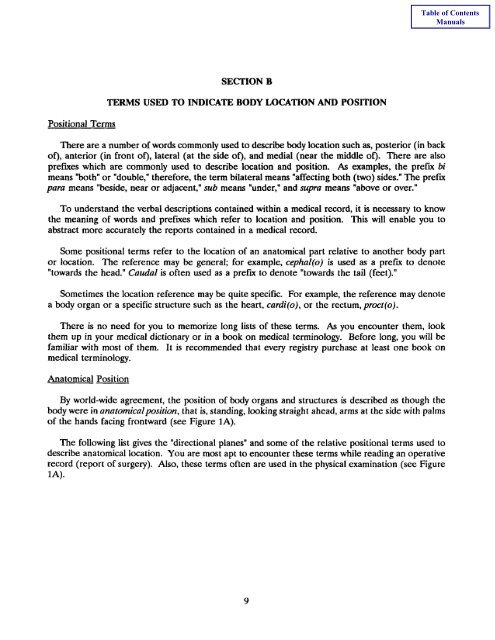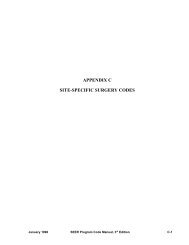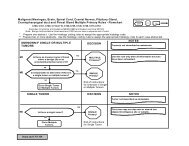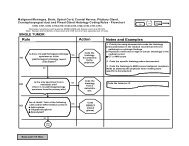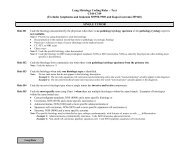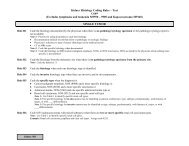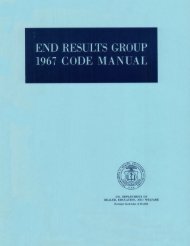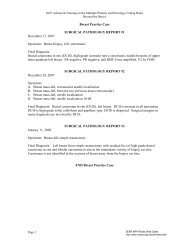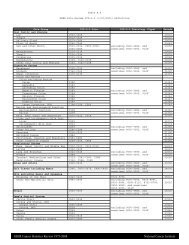- Page 2 and 3: SEER ProgramSelf Instructional Manu
- Page 4 and 5: CONTENTSBOOK 4: HUMAN ANATOMY AS RE
- Page 6 and 7: ILLUSTRATIONS(Figures 1-82, cont'd)
- Page 8 and 9: ACKNOWLEDGEMENTSPortions of Book 4
- Page 11: SECTIONAOBJECTIVES AND CONTENT OF B
- Page 15: BSECTIONBTERMS USED TO INDICATE BOD
- Page 19 and 20: (Tranmve_8o view) (SaaLqtsL v_ow)Fi
- Page 21 and 22: External Refers to locations which
- Page 23 and 24: PracticalExerciseListed below on th
- Page 25: Answersto Practical Exercise (conti
- Page 29 and 30: SECTION CTHE INTEGUMENTARY SYSTEMTh
- Page 31: Melanocytes (pigment cells), locate
- Page 34 and 35: Answer:Q1a. The two primary layers
- Page 37 and 38: Q2Name the three glands of the skin
- Page 39: • The sebaceous glands are widely
- Page 42 and 43: Answer:Q3Accessory skin organs are
- Page 44 and 45: MalignantTumorsA variety ol" malign
- Page 46 and 47: Answer:Q5b 1. Bowen's disease Intra
- Page 48 and 49: The classification of cutaneous mel
- Page 51 and 52: Q6In which of the following would y
- Page 53 and 54: Answer:Q6Liver. Malignant melanomas
- Page 55: Figure 6. LYMPHATICS OF THE SKIN(su
- Page 58 and 59: Answer:Q10The skin locations on the
- Page 61 and 62: SECTION DTHE LYMPHATIC SYSTEMThe ly
- Page 63 and 64: Q1The lymphatic system collectslymp
- Page 65 and 66: Lymphatic VesselsThe function of th
- Page 67 and 68:
Q3The lymphatic system collects lym
- Page 69 and 70:
LymphNodesLymph nodes are oval or b
- Page 71:
Lymph and Tissue FluidTissue fluid
- Page 74 and 75:
Answer:Q6The lymph nodes have two m
- Page 76 and 77:
ThymusThe thymus is situated in the
- Page 78 and 79:
Answer:Q9c 1. Spleen Filters bloodb
- Page 80 and 81:
QllLymphatics tend to parallelformi
- Page 82 and 83:
L..._ph Nodes of Head and NeckThe l
- Page 84 and 85:
Answer:Q14A general term for lymph
- Page 87 and 88:
Q18Lymph nodes of the thorax may be
- Page 89:
Lymph Nodes of the Abdomen and Pelv
- Page 92 and 93:
Answer:Q20Lymph nodes of the abdome
- Page 95 and 96:
Q22Match the lymph nodes on the lef
- Page 97 and 98:
Malignant and Benign TumorsBenign t
- Page 99 and 100:
Q23Benign tumors of lymphoid tissue
- Page 101 and 102:
Non-Hodgkin's Malignant LYmphoma. T
- Page 103 and 104:
Q27Non-Hodgkin's lymphomas may be d
- Page 105 and 106:
SECTIONETHE CARDIOVASCULARSYSTEM97
- Page 107 and 108:
SECTIONETHE CARDIOVASCULAR SYSTEMTh
- Page 109 and 110:
Q1The cardiovascular system consist
- Page 111 and 112:
Heartand PericardiumThe heart is a
- Page 113 and 114:
The Heart As a Pump.pulmonary circu
- Page 115 and 116:
Q5The heart has four chambers calle
- Page 117 and 118:
Q10Deoxygenated blood from the body
- Page 119 and 120:
BloodVesselsThere are three kinds o
- Page 121 and 122:
QllName the three kinds of blood ve
- Page 123 and 124:
BloodBlood is the fluid which circu
- Page 125 and 126:
Q14What are the three main types of
- Page 127 and 128:
Leukocytes, or white blood cells, f
- Page 129 and 130:
Q18White blood cells which are know
- Page 131 and 132:
LeukemiaLeukemia is a malignant dis
- Page 133 and 134:
Q20Malignant diseases of the blood-
- Page 135 and 136:
Q25Match the disease on the left wi
- Page 137 and 138:
SECTIONFTHE RESPIRATORYSYSTEM129
- Page 139 and 140:
SECTIONFTHE RESPIRATORYSYSTEMThe re
- Page 141 and 142:
Q1Name the parts of the respiratory
- Page 143 and 144:
Nose and Paranasal (Accessory_) Sin
- Page 145 and 146:
Q4What are the purposes of the nose
- Page 147 and 148:
NasopharynxThe pharynx is a muscula
- Page 149 and 150:
Q7The pharynx can be divided into t
- Page 151 and 152:
LarynxThe larynx or voice box is a
- Page 153 and 154:
MalignantTumorsThe glottic region i
- Page 155 and 156:
QlOThe three single cartilages in t
- Page 157 and 158:
TracheaThe trachea or windpipe is a
- Page 159 and 160:
Q14The windpipe or serves as a by w
- Page 161 and 162:
LHnRsThe lungs are cone-shaped orga
- Page 163 and 164:
Q16The main bronchus, pulmonary art
- Page 165 and 166:
Malignant TumorsCarcinoma of the lu
- Page 167 and 168:
Q19What is the interpleural space (
- Page 169 and 170:
Q24Match the description on the lef
- Page 171 and 172:
SECTIONGDIGESTIVESYSTEM163
- Page 173 and 174:
SECTIONGDIGESTIVESYSTEMThe main org
- Page 175 and 176:
Q1The main organs of the digestive
- Page 177 and 178:
MouthThe gastrointestinal tract beg
- Page 179 and 180:
Q5The lip consists of an exposed su
- Page 181 and 182:
• Tongue. The tongue is a mobile
- Page 183 and 184:
Q8The tongue is composed of covered
- Page 185 and 186:
• Floor of mouth. The floor of th
- Page 187 and 188:
QllMatch the structures on the left
- Page 189 and 190:
• Palate. The palate is the roof
- Page 191 and 192:
Q12What is the palate?Q13In what wa
- Page 193 and 194:
Salivary GlandsThere are three pair
- Page 195 and 196:
Q18Identify the major salivary glan
- Page 197 and 198:
Lymph Node DrainageThe regional lym
- Page 199 and 200:
Q21Match the sites on the left with
- Page 201 and 202:
PharynxThe pharynx is divided into
- Page 203 and 204:
Hypopharynx (laryngopharynx). The f
- Page 205 and 206:
Q23What is another name for the hyp
- Page 207 and 208:
Q25Match each structure on the left
- Page 209 and 210:
Q28To which segment of the pharynx
- Page 211 and 212:
EsophagusThe esophagus is a muscula
- Page 213 and 214:
The inner wall of the esophagus is
- Page 215 and 216:
Q30The esophagus is a muscular tube
- Page 217 and 218:
StomachThe stomach lies just below
- Page 219 and 220:
The functions of the stomach are to
- Page 221 and 222:
Q36Name three general functions the
- Page 223 and 224:
Small IntestineThe small intestine
- Page 225 and 226:
Q38The small intestine is aboutin l
- Page 227 and 228:
Large IntestineThe large intestine
- Page 229 and 230:
The blood supply to the wall of the
- Page 231 and 232:
The distributionof malignant tumors
- Page 233 and 234:
Q41The large intestine is aboutfeet
- Page 235 and 236:
Q43The ileocolic nodes are regional
- Page 237 and 238:
LiverThe liver is the largest inter
- Page 239 and 240:
Q45The most common primary tumor of
- Page 241 and 242:
GallbladderThe gallbladder is a pea
- Page 243 and 244:
Q46The function of the gallbladder
- Page 245 and 246:
PancreasThe pancreas is a gland sha
- Page 247 and 248:
Q48The pancreas plays an important
- Page 249 and 250:
SECTIONTHE URINARYHSYSTEM241
- Page 251 and 252:
SECTION HTHE URINARY SYSTEMThe urin
- Page 253 and 254:
Q1The urinary system consists of tw
- Page 255 and 256:
The Structural and Functional Unit
- Page 257 and 258:
The function of the kidney is to re
- Page 259 and 260:
Q4Why is blood circulatedthrough th
- Page 261 and 262:
Regional Lymph NodesThe lymphatics
- Page 263 and 264:
Q8The regional lymph node drainage
- Page 265 and 266:
UretersEach kidney is connected to
- Page 267 and 268:
Q12Q13What is the tube which carrie
- Page 269 and 270:
Urinary BladderThe urinary bladder
- Page 271 and 272:
Regional Lymph NodesThe regional ly
- Page 273 and 274:
Q14What is the term for the muscula
- Page 275 and 276:
UrethraThe urethra is a membranous
- Page 277 and 278:
Q2oThe renal pelvis is:--'l a. a mu
- Page 279 and 280:
SECTIONITHE REPRODUCTIVESYSTEM271
- Page 281 and 282:
SECTIONITHE REPRODUCTIVESYSTEMFemal
- Page 283 and 284:
Q1The female reproductive organs ar
- Page 285 and 286:
The uterus has thick walls and a sm
- Page 287 and 288:
Q6For each of the sites below, list
- Page 289 and 290:
OvariesThe ovaries, female gonads1,
- Page 291 and 292:
Q7Match the sites on the left with
- Page 293 and 294:
Malignant TumorsCommon histologic t
- Page 295 and 296:
Q13The fimbriae of the fallopian tu
- Page 297 and 298:
VaginaThe vagina is situated poster
- Page 299 and 300:
Q14The vagina is situated between t
- Page 301 and 302:
5. Endometrioid carcinoma e. An ade
- Page 303 and 304:
a 3. Krukenberg tumor A metastatic
- Page 305 and 306:
BreastThe breasts, or mammary gland
- Page 307 and 308:
Q19The breasts overlie themuscles.Q
- Page 309 and 310:
The female breast is classified acc
- Page 311 and 312:
Q22One of the first and most freque
- Page 313 and 314:
Malignant TumorsNinety percent of a
- Page 315 and 316:
REVIEWTESTMatch the descriptions on
- Page 317 and 318:
Male ReproductiveSystemThe male rep
- Page 319 and 320:
Q25The male gonads consist of a pai
- Page 321 and 322:
The internal structure of the testi
- Page 323 and 324:
Q29Match the structures on the left
- Page 325 and 326:
Seminal VesiclesThe seminal vesicle
- Page 327 and 328:
Q29Match the structures on the left
- Page 329 and 330:
PenisThe penis consists of erectile
- Page 331 and 332:
MalignantTumorsThe most common mali
- Page 333 and 334:
Q30Male hormonesare produced primar
- Page 335 and 336:
SECTIONTHE ENDOCRINEJSYSTEM327
- Page 337 and 338:
SECTION JTHE ENDOCRINE SYSTEMThe en
- Page 339 and 340:
ThyroidGlandThe thyroid gland consi
- Page 341 and 342:
Adrenal (Suprarenal) GlandsThere ar
- Page 343 and 344:
Q1Match the terms on the left with
- Page 345 and 346:
Q4Match the endocrine glands on the
- Page 347 and 348:
Answer:Q3The endocrine system consi
- Page 349 and 350:
SECTIONTHE SKELETALKSYSTEM341
- Page 351 and 352:
SECTION KTHE SKELETAL SYSTEMThe ske
- Page 353 and 354:
Q1The skeletal system is composed o
- Page 355 and 356:
Bone/CartilaginousTissueBone, or os
- Page 357 and 358:
Q4One characteristic which distingu
- Page 359 and 360:
Classification of BonesBones may be
- Page 361 and 362:
Q8The purpose of the sesamoid bones
- Page 363 and 364:
Figure 62. HAVERSIAN SYSTEM OF THE
- Page 365 and 366:
QllName each of the five numbered p
- Page 367 and 368:
AXIALSKELETONThere are a total of e
- Page 369 and 370:
Bones of the Thorax. There are 25 b
- Page 371 and 372:
Q15Name the cranial bones:1.2.3.4.5
- Page 373 and 374:
Answer:Q15The cranial bones are:1.
- Page 375 and 376:
APPENDICULARThe appendicularSKELETO
- Page 377 and 378:
Q18Match the descriptions on the le
- Page 379 and 380:
Q21Match each of the tumors on the
- Page 381 and 382:
Answer:Q18d 1. A bone which connect
- Page 383 and 384:
SECTIONTHE MUSCULARLSYSTEM375
- Page 385 and 386:
SECTIONTHE MUSCULARLSYSTEMThe muscu
- Page 387 and 388:
Q1Name the three types of muscle fo
- Page 389 and 390:
Tendons, Fascia, and LigamentsEach
- Page 391 and 392:
Q6["] True ['-'1 False 1. Muscles h
- Page 393 and 394:
SkeletalMusclesSome of the skeletal
- Page 395 and 396:
Q8What are the three general functi
- Page 397 and 398:
QllMatch the muscle groups on the l
- Page 399 and 400:
SECTIONTHE NERVOUSMSYSTEM391
- Page 401 and 402:
SECTION MTHE NERVOUS SYSTEMThe nerv
- Page 403 and 404:
Q1The central nervous system is mad
- Page 405 and 406:
CENTRAL NERVOUS SYSTEMThe central n
- Page 407 and 408:
Midbrain (mesencephalon)The midbrai
- Page 409 and 410:
PERIPHERAL NERVOUS SYSTEMThe periph
- Page 411 and 412:
Cranial NervesThe Cranial nerves ca
- Page 413 and 414:
Benign TumorsBenign tumors of the b
- Page 415 and 416:
Q6Match each term on the left with
- Page 417 and 418:
SECTIONNSENSORYORGANS409
- Page 419 and 420:
SECTIONNSENSORYORGANSThere are five
- Page 421 and 422:
Q1What are the five major senses of
- Page 423 and 424:
The Sense of Vision (Eye)The eye is
- Page 425 and 426:
Q3What are the three layers which c
- Page 427 and 428:
The accessory structures of the eye
- Page 429 and 430:
Q5The eyeball is/is not a solid sph
- Page 431 and 432:
Regional Lymph NodesMuch of the eye
- Page 433 and 434:
Q8Name the lymph nodes which drain
- Page 435 and 436:
The Sense of Taste (Gustatory Sense
- Page 437 and 438:
QllReceptors for the sense of taste
- Page 439 and 440:
The Sense of Smell (Olfactory Senso
- Page 441 and 442:
Q13The nasal fossa is divided into
- Page 443 and 444:
The Sense of Hearing (Ear)The organ
- Page 445 and 446:
Q16Match the parts of the ear on th
- Page 447 and 448:
APPENDIXAHISTOLOGIC TYPE/PRIMARY SI
- Page 449 and 450:
APPENDIX A: HISTOLOGIC TYPE/PRIMARY
- Page 451 and 452:
APPENDIXBRULES FOR DETERMINING MULT
- Page 453 and 454:
APPENDIX BRULES FOR DETERMINING MUL
- Page 455 and 456:
DETERMINATION OF SUBSEQUENT PRIMARI
- Page 457 and 458:
DETERMINATION OF SUBSEQUENT PRIMARI
- Page 459 and 460:
DETERMINATION OF SUBSEQUENT PRIMARI
- Page 461 and 462:
DETERMINATION OF SUBSEQUENT PRIMARI
- Page 463 and 464:
DETERMINATION OF SUBSEQUENT PRIMARI
- Page 465 and 466:
DETERMINATION OF SUBSEQUENT PRIMARI
- Page 467 and 468:
DETERMINATION OF SUBSEQUENT PRIMARI
- Page 469 and 470:
DETERMINATION OF SUBSEQUENT PRIMARI
- Page 471 and 472:
DETERMINATION OF SUBSEQUENT PRIMARI
- Page 473 and 474:
DETERMINATION OF SUBSEQUENT PRIMARI
- Page 475 and 476:
DETERMINATION OF SUBSEQUENT PRIMARI
- Page 477 and 478:
APPENDIXCOTHER ICD-O-2 CODES TO BE
- Page 479 and 480:
APPENDIXCOTHER ICD-O-2 CODES TO BE
- Page 481 and 482:
SELECTEDBIBLIOGRAPHY473
- Page 483 and 484:
SELECTED BIBLIOGRAPHYAckerman, L.V.
- Page 485 and 486:
INDEX477
- Page 487 and 488:
INDEXAbdomen (abdominal), 12, 13, 8
- Page 489 and 490:
Alveolar, 297, 299, 300, 317Alveoli
- Page 491 and 492:
Basement membrane (basal lamina), 2
- Page 493 and 494:
Blood (see also cardiovascular syst
- Page 495 and 496:
Bone tissue, Axial (axis), Skull (d
- Page 497 and 498:
Capillaries (continued)Bowman's cap
- Page 499 and 500:
Cell type (see also Blood, Lymphati
- Page 501 and 502:
Colloid adenoma, 331Colon, 165, 168
- Page 503 and 504:
Digestive system (continuedMucosa,
- Page 505 and 506:
Endometrium, 274-277, 281, 285, 441
- Page 507 and 508:
Facial(continued)Lacrimal, 360, 363
- Page 509 and 510:
Gland (see also specific gland) ico
- Page 511 and 512:
Heart (see also Cardiovascular syst
- Page 513 and 514:
Hormone (continued)Tri-iodothyronin
- Page 515 and 516:
Intestine (see also Digestive syste
- Page 517 and 518:
Lamina propria (see also Digestive
- Page 519 and 520:
Liposarcoma (primary site for), 441
- Page 521 and 522:
Lymph nodes (continued)Hepatic, 81,
- Page 523 and 524:
Lymphatic (collecting) system (cont
- Page 525 and 526:
Melatonin hormone, 332Membrane, 10,
- Page 527 and 528:
Mucosa (see Digestive system) (cont
- Page 529 and 530:
Nares (see Nose)Nasal bone (facial)
- Page 531 and 532:
Nose (see also Respiratory system)
- Page 533 and 534:
Paranasal sinus, frontal, maxillary
- Page 535 and 536:
Pituitary gland (Hypophysis) (conti
- Page 537 and 538:
Reproductive system (male), 267, 28
- Page 539 and 540:
Seminal vesicle, duct and tubule, 3
- Page 541 and 542:
Stomach (see also Digestive system)
- Page 543 and 544:
Testis (male gonad) (continued)Semi
- Page 545 and 546:
Tonsil (see also Lymphatic system)
- Page 547 and 548:
Tumor (see also specific histologic
- Page 549 and 550:
Uterus (see also Reproductive syste
- Page 551:
Waldeyer's ring, 68-70, 94Lymphoma


